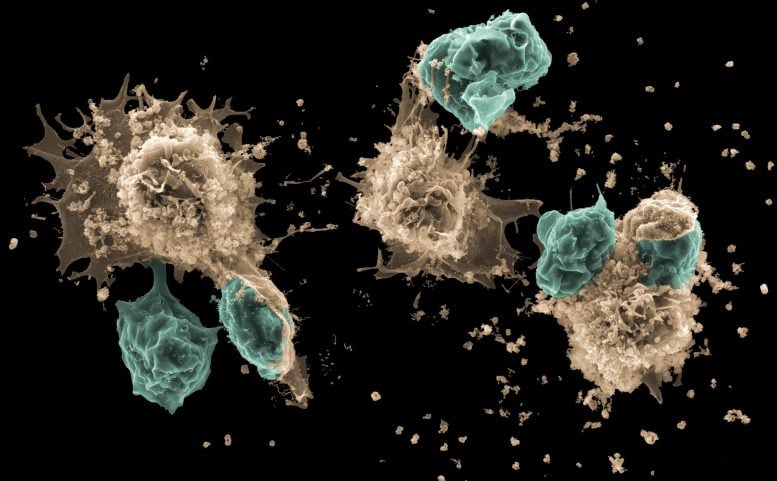
Researchers have discovered a surprising interaction between mast cells and neutrophils in allergic reactions, using specialized microscopy.
Mast cells can trap and engulf neutrophils, creating a cell-in-cell structure known as “mast cell intracellular trap” (MIT). This interaction boosts mast cell function and could lead to new approaches for treating allergies and inflammatory diseases. The findings also highlight the intricate relationships among immune cells and their roles in inflammation and immune defense.
Understanding Inflammation: Body’s Protective Response
Inflammation is the body’s response to harmful stimuli, characterized by heat, pain, redness, swelling, and loss of tissue function. When balanced, inflammation protects the body by clearing harmful agents and initiating tissue repair. However, excessive inflammation can cause tissue destruction and disease. Key players in this process are various immune cells, which work together during inflammation. The type of immune cells involved often varies depending on the harmful stimulus, influencing the outcome of the inflammatory response.
Immune Cell Trapping During Allergic Responses
Mast cells, residing in tissues and critical for initiating inflammation, are filled with granules containing pro-inflammatory substances. These granules are released upon encountering potential dangers, including allergens, causing allergic reactions. In many people, mast cells also react to seemingly harmless environmental factors, which then act as allergens and cause allergies. The interaction between mast cells and other immune cells at sites of allergic responses has been largely unexplored.
A research group at the Max Planck Institute of Immunobiology and Epigenetics used specialized microscopy to visualize the real-time dynamics of activated mast cells and other cell types during allergic reactions in living mouse tissues. Led by Tim Lämmermann, since October 2023 Director at the Institute of Medical Biochemistry at the University of Münster, the team discovered a surprising interaction: neutrophils were found inside mast cells.
“We could hardly believe our eyes: living neutrophils were sitting inside living mast cells. This phenomenon was completely unexpected and probably would not have been discovered in experiments outside a living organism and highlights the power of intravital microscopy,” says Tim Lämmermann.
Pulling a Neutrophil Trick To Trap Neutrophils
Neutrophils are frontline defenders of our immune system, responding quickly and broadly to potential threats. They circulate in the blood and quickly exit blood vessels at sites of inflammation. They are well-equipped to combat invaders such as bacteria or fungi by engulfing the invaders, releasing antimicrobial substances, or forming web-like traps known as “neutrophil extracellular traps.” Additionally, neutrophils can communicate with each other and form cell swarms to combine their individual functions for the protection of healthy tissue. While much is known about neutrophils’ role in infections and sterile injuries, their role in inflammation caused by allergic reactions is less understood.
“It quickly became clear that the double-pack immune cells were no mere coincidence. We wanted to understand how mast cells trap their colleagues and why they do it,” explains Michael Mihlan, first and co-corresponding author of the study published today (August 2) in the journal Cell. Once the team was able to mimic the neutrophil trapping observed in living tissue in cell culture, they we were able to identify the molecular pathways involved in this process. The researchers found that mast cells release leukotriene B4, a substance commonly used by neutrophils to initiate their own swarming behavior.
By secreting this substance, mast cells attract neutrophils. Once the neutrophils are close enough, mast cells engulf them into a vacuole, forming a cell-in-cell structure that the researchers refer to as a “mast cell intracellular trap” (MIT). “It is ironic that neutrophils, which create web-like traps made of DNA and histones to capture microbes during infections, are now trapped themselves by mast cells under allergic conditions,” says Tim Lämmermann.
Advancing Our Understanding of Inflammatory and Allergic Reactions
With the help of an international team, the researchers confirmed the formation of MITs in human samples and investigated the fate of the two cell types involved after trapping. They found that trapped neutrophils eventually die, and their remains get stored inside mast cells
“This is where the story takes an unexpected turn. Mast cells can recycle the material from the neutrophils to boost their own function and metabolism. In addition, mast cells can release the newly acquired neutrophil components in a delayed manner, triggering additional immune responses and helping to sustain inflammation and immune defense,” says Michael Mihlan.
“This new understanding of how mast cells and neutrophils work together adds a whole new layer to our knowledge of allergic reactions and inflammation. It shows that mast cells can use neutrophils to boost their own capabilities – an aspect that could have implications for chronic allergic conditions where inflammation occurs repeatedly,” says Tim Lämmermann.
The researchers have already begun investigating this interaction in mast cell-mediated inflammatory diseases in humans, exploring whether this discovery could lead to new approaches to treating allergies and inflammatory diseases.
Reference: “Neutrophil trapping and nexocytosis, mast cell-mediated processes for inflammatory signal relay” by Michael Mihlan, Stefanie Wissmann, Alina Gavrilov, Lukas Kaltenbach, Marie Britz, Kristin Franke, Barbara Hummel, Andrea Imle, Ryo Suzuki, Manuel Stecher, Katharina M. Glaser, Axel Lorentz, Peter Carmeliet, Takehiko Yokomizo, Ingo Hilgendorf, Ritwick Sawarkar, Alba Diz-Muñoz, Joerg M. Buescher, Gerhard Mittler, Marcus Maurer, Karoline Krause, Magda Babina, Luise Erpenbeck, Marcus Frank, Angelika S. Rambold and Tim Lämmermann, 2 August 2024, Cell.
DOI: 10.1016/j.cell.2024.07.014